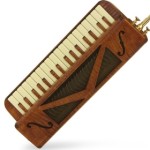Keyboard harmonica: accordion style vs. melodica style
Tagged: Vibrandoneon
- This topic has 15 replies, 6 voices, and was last updated 9 years ago by
 Ofir.
Ofir.
-
AuthorPosts
-
April 17, 2015 at 2:16 pm #4705
 QuetscherParticipant
QuetscherParticipantHey guys, this is an absolute fascinating discussion in the topic “A new piano and melodica video”, and I’d like to join you and share a few of my thoughts with you. But I decided to create a new topic for this – you will see why…
First of all, when reading your comments about collecting as many melodicas as possible or finding the one and only instrument, I find myself standing a little between those both poles. Like Ofir or Daren, I would appreciate if there was such a one-size-fits-all instrument, but when I listen for example to Daren’s review video of 13 melodicas, I can imagine the joy of having many similar but still different sounding instruments just like a painter would not only use one green but many shades of green (Grey? LOL!). So when I dream of my perfect one-in-all melodica, it should be possible to create different sounds with that one melodica, just like a trumpet player using straight, harmon or cup mutes.
You would say this isn’t possible for a melodica, wouldn’t you? I say, it IS possible, but only if you imagine the two different ways of constructing a (and now I’m using Lowboy’s term for once) keyboard harmonica: the first way is a MELODICA-like construction (meaning the reeds and the air chamber are placed BENEATH the keyboard, this is how most keyboard harmonicas are constructed), the second way is an ACCORDION-like construction, meaning the reeds and the air chamber are placed BESIDES the keyboard and the levers that move the valves are placed visibly at the end of the keys and can be covered with a grille. This is the way the Vibrandoneon and the Eolina are built.
Now the sound of each keyboard harmonica is certainly defined by the material and quality of the reeds, by the size and material of the air chamber and by some other factors. But the sound of an accordion-like built keyboard harmonica can be influenced after it has already left the instrument simply by the fact that it still has to pass the grille – which you can construct just the way you want to. It may be made of different materials with different irridation, it may be open or closed – everything is possible and everything may lead to the perfect sound you’re seeking!
Enough theory: I recorded 7 Variations of a simple melody:
1. With open grille
2. With closed grille
3. With alternately open and closed grille (WahWah)
4. With open grille + flutter tongue
5. With closed grille + airy sound
6. With closed grille + overblowing + flutter tongue + vibrato
7. With half closed grille + bendings
Here it is:The first three are recordings of my Vibrandoneon MKII with the original wooden grille, either covered or uncovered, played without special blowing techniques. In Variation 4-6 I added some blowing techniques, and Variation No.7 completes the recording with bendings. This is still just a little excerpt of what is possible with an accordion-like keyboard harmonica, but in my opinion this is the way a keyboard harmonica should be constructed when you want to make it an all-in-one instrument. And this is not a question of price, you can also build much cheaper instruments than the Vibrandoneon that way!
April 17, 2015 at 10:00 pm #4707 Melodica-MeParticipant
Melodica-MeParticipantQuetscher, The best feature in the Vibrandoneon is that it has two separate reed chambers that give you (3) different sounds. As Daren wrote it is a great instrument for classical music and in my opinion for jazz as well, as I have used it in several recordings. Even though it is by far the best instrument of its kind made not to mention the most expensive, I still need to seek other melodicas depending on the style of the music. Since the future of the New Vibrandoneon from Ballone Burini is unknown, there is know way of knowing what features will be available and if any special configurations can be ordered that may help eliminate the need for many different Melodicas, especially in the blow in on one set of reeds and suck out at a different set of reed configuration and how the chambers will be controlled. or if can be ordered with different types of reeds for each chamber? My savings has grown but my patience has not. I also hope it comes in the hard lux case and not a soft case as I have seen on the Eolina. I bought my Vibrandoneon VB600PMK 2 registers about 10 years ago paid a little over $3,000.00 with vat and shipping. I would assume that the new one will be at least that if not higher. Have you had any luck with your friends there?
Melodica-MeApril 17, 2015 at 10:09 pm #4708 Alan BrintonParticipant
Alan BrintonParticipantYour insights here are so good and the illustrative performance so well executed that it’s hard to know what to say, Quetscher!
April 18, 2015 at 11:00 am #4710 LowboyParticipant
LowboyParticipantQuetscher:
I like your perspective and your revealing recording. Great sensitive playing too. Thanks.
I agree that getting more expressiveness out of a melodica is THE challenge for instrument designers and players alike.
As my last recording demonstrated, and as you (everyone here) have heard me say many times (but which I will repeat again for the benefit of newcomers), there already is a melodica that can do all you demonstrated with your Vibrandoneon MKII, and it costs about $25 to $75 on Ebay. It is the Hohner Piano 26/27/32 series of melodicas, where not just holes but the sound outlet valves are located on the back side of the instrument (opposite side of the keys).
Vibrato/tremolo, volume modulation, timbre modulation, bending, distortion from playing hard, distortion from humming into the mouthpiece; ability to use microphone techniques, in particular, big bass from proximity effect and microphone distortion from compression; ability to easily modify the sound holes with external devices (think mutes and custom sound chambers), phenomena I hear but can’t even explain, and a few thing I am not ready to reveal yet are all possible with the Hohner Piano 26/27/32.
And, apparently, this $50 melodica is so versatile that is being used in serious music as the recent video of Waltz Gramophone shows.
I understand the comparison of the Hohner Piano 26/27/32 to a Vibrandoneon MKII is not a fair one. But the fact remains that the design of these Hohners, perhaps unintentionally, makes them more expressive than most any other melodica. Or so I thought. Quetscher has just demonstrated that with some creativity and the right design, you can increase the expressiveness of other melodicas as well.
What secrets lay inside (or outside) a Hohner Professional 36 I wonder?
The caveat is you need to like the sound, you need to want to go there, you need to put in the considerable time needed to learn the techniques (which are not easy to execute), and in the case of the Hohners, you need to put up with the shortcomings of what is otherwise a pretty average melodica.
Lowboy
April 18, 2015 at 7:24 pm #4724 QuetscherParticipant
QuetscherParticipantHi Lowboy, thanks for your comment and thanks for reminding me of your great “Belly Wah” (that I didn’t forget anyway). I just want to make clear that I didn’t want to compare different melodicas, no matter if cheap or expensive, but different types of construction (it is by pure accident that the only accordion-style built instrument I own is not a VW Golf but a Cadillac…). It is great that a WahWah is also possible with a melodica-style constructed keyboard harmonica – nevertheless if we are talking about a One-size-fits-all keyboard harmonica, I would prefer an accordion-style construction because you can produce a WahWah without having to shake the whole Instrument, so you can always keep the same distance to the microphone, and you can WahWah during a whole phrase and not only during long notes. And let me emphasise that I’m not only dreaming of high end wooden accordion-style instruments but of really affordable keyboard harmonicas!
April 18, 2015 at 7:25 pm #4725 QuetscherParticipant
QuetscherParticipantHi Alan, thanks a lot for your encouragement!
April 18, 2015 at 7:39 pm #4727 QuetscherParticipant
QuetscherParticipantHi Melodica-Me, thanks for your answer. When speaking of a One-size-fits-all melodicas I’m dreaming just like you of two reed blocks, either for two sets of reeds in different octaves or for different kinds of reeds (harmonica style – accordion style) or for two identical sets of reeds as a back-up during concerts or recordings. I haven’t heard anything of my Ballone Burini friends, so I don’t know if our dreams will come true, but anyway this topic (as I already wrote Lowboy) wasn’t installed to discuss the Vibrandoneon but different construction types – nevertheless I will certainly inform you if I have news…
April 19, 2015 at 12:35 am #4733 DarenKeymaster
DarenKeymasterGreat playing Quetscher, and thanks for the clear examples, also recorded very nicely! You must have done a lot of practice on bending those notes 🙂
April 19, 2015 at 2:28 am #4736 LowboyParticipant
LowboyParticipantYes I understand exactly what you are saying Quetscher.
Here is the discovery I think you triggered: any melodica where the sound valves, for lack of the correct term, are not projecting sound through the keyboard offer a greater opportunity modification, modulation, and expressiveness.
When the sound is projected through the keyboard, as is the case with most melodicas, you can’t modify/modulate the sound source easily because your right hand is in the way playing the keyboard.
As soon as the valves are placed away from the keyboard as in an accordion-style arrangement (Vibrandoneon) or on the back of the melodica (Hohner Piano 26/27/32 arrangement), you have a greater capability to modify the instrument or modulate the sound.
Regards,
Lowboy
April 19, 2015 at 5:09 am #4738 QuetscherParticipant
QuetscherParticipantThanks a lot, Daten! To be honest, there is a trick that enables you to bend notes better (and without too much pressure of breath) and that has again to do with the accordion-style construction of the Vibrandoneon – that’s why I recorded this Variation. But I still have to experiment with this, so I will explain another time:-)
@Lowboy: couldn’t have explained better, thanks!April 19, 2015 at 10:46 am #4742 DarenKeymaster
DarenKeymasterLowboy, beautifully summed up!
Quetscher, looking forward to your bending technique thread 🙂
April 19, 2015 at 11:47 am #4744 LowboyParticipant
LowboyParticipantIf all this discussion leads me to purchase a high end melodica one of these days, my wife will show no mercy on you. I am not going to take the hit on this. I will pass the responsibility directly along to you as a group … something about brainwashing could work. Lowboy
April 20, 2015 at 6:26 am #4750 OfirParticipant
OfirParticipantBit late, but I owe you a response.
Quetscher, this is terrific! I like your approach, and also trying to generalize the problem (which Lowboy documented eventually very well).
Oh, and your playing is beautiful; I also explored the rest of your Soundcloud channel 🙂It is also very interesting to hear the same instrument in different setups, experiencing such a variety of sounds.
I would be interested though to hear about the basic structure of the Vibrandoneon’s reed chambers, and the different sounds that it allows even without any further modifications.And like the others here, I’m very much interested in your bending technique!
April 20, 2015 at 12:49 pm #4756 QuetscherParticipant
QuetscherParticipantHi Ofir,
thanks a lot for your comment, I’m really glad I could make clear my intentions concerning the possibilities of varying the sound of one and the same instrument.
A Vibrandoneon is built a little like the keyboard side of a small accordion – you have two sets of reeds on a reed block that is (unfortunately!) not removable (this would make tuning so easy!) but glued into the instrument thus dividing the air chamber in two parts. Either you can play each set of reeds separately or both sets together – so you have 3 sound options: middle octave (8’ register), high octave (4’ register) or combined 8’+4’ which of course sounds in octaves.
Just have a look on this site:There you can find a photo of the inside of the Vibrandoneon plus two sound examples, the first one (“Barchino”) played with 8’, then 8’+4’.
In my opinion it’s not necessary to have two different sets of reeds, it leads away from the idea of keeping things simple – which is an idea that I strongly associate with the melodica. But on the other hand sometimes it sounds really great, especially for tango music!April 20, 2015 at 12:54 pm #4757 QuetscherParticipant
QuetscherParticipantI don’t fear your wife, Lowboy (just living too far from you, haha!). The only thing she could really hurt me with would be finding a way to destroy this site…
-
AuthorPosts
- You must be logged in to reply to this topic.
